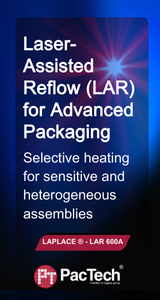|

|
| Viewpoint | ||
January 28, 2020
VIEWPOINT 2020: David Butler, EVP and General Manager, SPTS Technologies Ltd
Sub-6GHz 5G is an evolution of LTE, but things get far more complicated when you move to millimeter wave (mmWave) 5G, a frequency shift that will give us far greater bandwidths and much lower latency. In a 4G phone, the antenna is separate from where the amplification and filtering is done in the front-end module (FEM). But for a mmWave phone, you need to integrate the antenna inside the RF-FEM, the so-called antenna-in-package. Putting the antenna closer to the RF chips boosts the signal and minimizes signal loss. Qualcomm, Huawei, Mediatek and Samsung are all developing mmWave antenna modules, and the leading OSATS and foundry are developing antenna in package modules based on fan-out (FO) technology[3]. As one of the pioneers of fan-out wafer processing from more than 10 years ago, we at SPTS are excited about this new avenue for FO processing. The new applications for fan-out technology are predominantly about high density, using multi-levels of redistribution layer (RDL) with minimum line spacing of <5µm. Controlling to these dimensions sets new challenges for the equipment makers in terms of warpage control, contact resistance, and always productivity and cost. To reduce contact resistance in small dimension contact pads, SPTS has a preclean module for its Sigma fxP cluster PVD system called the Inspira SE. Our third generation of preclean, the Inspira SE features dynamic contamination control to keep the contacts clean. FOWLP is not the only high density packaging technology of course; through silicon vias (TSVs) are being used in increasing quantities for high performance computing applications. For memory and interposers, plus image sensors, TSVs are unquestionably in high volume production. We're expecting an uptick in via reveal activity, where our dry etch and low temperature PECVD processes have benefits for bulk silicon removal and dielectric stress control. The other packaging area of focus for us is plasma dicing. We now have a mini-line in our UK factory complete with taping, laser grooving and singulation by plasma. Applications for plasma dicing have increased over recent years, starting with tiny RFIDs, and now focused on die strength for very thin die applications, and cleanliness for particle-sensitive die to wafer bonding. We're also seeing interest from automotive companies, who view plasma dicing as a very promising method to meet the demanding reliability specifications needed in their field. References [1] Qorvo Analyst Day, 23 May 2018 (https://ir.qorvo.com/static-files/06804f9b-6fe7-4cfd-9ed2-cf110fcf640a) [2] Transcript of Qorvo Q2 2020 Earning Call (31 Oct 2019) - https://www.fool.com/earnings/call-transcripts/2019/11/01/qorvo-qrvo-q2-2020-earnings-call-transcript.aspx [3] https://semiengineering.com/challenges-grow-for-5g-packages-and-modules/ David Butler, EVP and General Manager SPTS Technologies Ltd http://www.spts.com |
|
Free Newsletter Subscription
Semiconductor Packaging News is built for professionals who bear the responsibility of looking ahead, imagining the future, and preparing for it. Insert Your Email Address |
|

|

